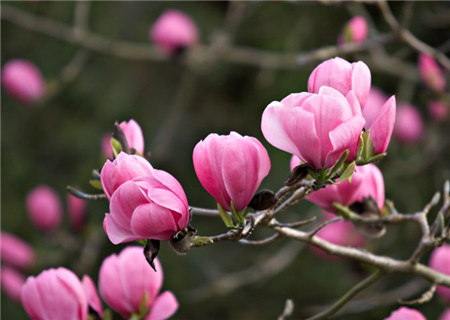The planting method of Phoenix flower
Phoenix flower is native to the tropics, which is most suitable for planting in high temperature and humid environment, and grows in the temperature range of 20-30 degrees Celsius, so it is the most exuberant season in late spring, early summer and autumn in China. Phoenix mackerel is not cold-resistant, so plants planted in the open air should be kept warm in winter to keep their temperature not lower than 10 degrees Celsius, otherwise they will freeze to death.
Soil: Phoenix can tolerate relatively poor soil, but its favorite fertile, rich in organic matter and loose soil environment, growing in the most suitable soil environment, its Phoenix flowers are more gorgeous and moving. The root of Phoenix mackerel belongs to shallow root, but its root system is very developed and firmly rooted, so it has strong resistance to wind energy.

How to raise Phoenix flowers
Phoenix flower is native to the tropics, its nature likes the high temperature and humid environment, the most suitable temperature range for its growth is 20 ℃, so its growth is the most exuberant season in late spring, early summer and autumn in China. Phoenix wood is not resistant to cold, so the plants planted in the open air should be kept warm in winter to keep its temperature not lower than 10 ℃, otherwise it will freeze to death.
Soil: Phoenix wood can tolerate relatively poor soil, but it prefers fertile, organic matter-rich and loose soil environment. It grows in the most suitable soil environment, and its Phoenix flowers are more gorgeous and moving. The root of Phoenix wood belongs to shallow root, but its root system is very developed and firmly rooted, so it has a strong ability to resist wind.
Transplant and colonization: the transplant of Phoenix flower is aimed at seedling growth, and the seedlings of about 2 years old should be transplanted to a fertile, loose and sunny environment. Transplanting is usually carried out in early spring, and it is appropriate to ensure that the row spacing of the plant is about 60 cm after transplantation. After transplanting 1 Mel for 2 years, the seedlings can be colonized as soon as they grow up, and the requirements for the soil are not high, and the soil is also barren, but the site selection should also be open and sunny.
Watering: Phoenix trees can withstand drought, but the amount of watering should be controlled. Because of the rhizobia in its roots, nitrogen fixation can increase soil fertility in barren soil, but stagnant water will kill Daozhou rhizobia and affect the normal growth of the whole plant.
The Propagation method of Phoenix Flower
The common propagation methods of Phoenix flowers are sowing and reproduction. Seeds are usually sown in spring and mature in 12 months. The seeds need to be soaked before sowing, soaking the seeds with boiling water, then soaking them for about 2 days after cooling with water, and changing water once in the middle. After treatment, the seeds can be sown, generally begin to germinate in about a week, and begin to emerge in 3 weeks.
Phoenix Flower language
Phoenix flower is the flower of Phoenix wood, which is native to Madagascar and is the local national flower and national tree. Phoenix flowers are often seen on campus. The flowering day of Phoenix wood is usually around May, which is the season of graduation and is full of sadness of parting everywhere. In the sun, the flaming Phoenix flowers add a bit of affection to parting, like a teacher exhorting a student who is about to travel far away. Therefore, the flower language of Phoenix flower is: ignore and miss.
When will the Phoenix blossom
Phoenix wood is a tropical variety, its young plants can not blossom, generally after planting 6 Mel for 8 years before flowering, flowering is like a different kind of red. The Phoenix flower begins to germinate at the beginning of the month every year, and begins to blossom after April. The flowers will bloom around May. Its petals are usually axillary or terminal, and the diameter of the flower is larger than that of the average flower, reaching about 7mi 15cm. The number of petals is 5, which is the same as its calyx, and most of them are bright red.
The flowering period of Phoenix flower is longer, which can reach 5 Mel for about 8 months. After it began to bloom around May, it belonged to the peak of its growth before July, and the flowers were red. However, when the temperature surged in July, its growth activity began to weaken, until the temperature dropped in late August and began to reach a growth peak again, and then began to slow down in winter until the Phoenix tree began to shed its leaves around December-January.
What is the Phoenix flower? Culture methods and matters needing attention of Phoenix flower
Speaking of Phoenix flower, you may have seen it, but you don't know its name. Let's follow the editor to know about Phoenix flower. Phoenix flower is named after "Leaf such as Feather of Flying Phoenix, Flower if the Crown of Danfeng", alias Goldilocks, Safflower couplet Tree, Fire Tree, Cottonflower and so on. Phoenix wood is regarded as one of the most colorful trees in the world because of its bright red or orange flowers and bright green pinnately compound leaves. What is the breeding method of Phoenix flower? What are the matters needing attention in Phoenix flower culture?
Growth habit
Phoenix wood is a tropical tree species, which begins to blossom after planting for 6 ~ 8 years. It likes the environment of high temperature, humidity and sufficient sunshine. The suitable temperature for growth is 20-30 ℃, not hardy, and the winter temperature is not lower than 10 ℃. It is suitable for sandy loam with deep and fertile soil rich in organic matter, good drainage, drought tolerance and barren soil for fear of stagnant water. Generally, the height of 1-year-old can reach 1.5-2 meters, and that of 2-year-old can reach 3-4 meters, and the flowers can be planted for 6-8 years.
In South China, winter buds germinate in early February, and the growth peak is from April to July. In late July, due to high temperature, the growth decreases. After the middle and late August, the temperature drops and the growth accelerates. The growth slows down after October, and leaves fall from December to January of the following year.
Cultivation techniques
Seeds are commonly used to sow and raise seedlings. A thousand seeds weigh about 400 grams. The seed coat is difficult to absorb water. It is necessary to use 80 ℃ warm water to scald the seed to promote germination. After natural cooling, continue to soak for 24 hours and drain.
When sowing by strip sowing, the seedlings are sensitive to frost, comprehensive fertilizer can be applied in the early stage, less nitrogen fertilizer can be applied, and fertilization should be stopped after autumn to promote Lignification as soon as possible. In winter, if the leaves have not fallen off, they can be cut off manually and covered with film or covered with a single plant to prevent frost. One-year-old seedlings can be planted in the nursery.
Reproduction method
Phoenix wood is mainly propagated by sowing. The seeds matured in December, pods were collected, the seeds were dried and stored, and the seeds were sown in the following spring. Soak the seeds in boiling water before sowing, continue to soak for 1-2 days after cooling, change the water for 1-2 times, germinate 6-7 days after sowing, and produce seedlings in more than 20 days, and the annual seedlings can reach about 1.5 meters.
Cultivation method
The soil should be fertile, deep, well drained and planted in the sun. The seedlings need to be transplanted once after growing for 1-2 years, and the transplanting should be carried out in early spring. When the row spacing is about 60 cm, 3-year-old seedlings can be used for planting. The planting site should be open and sunny, and should be fully watered when the weather is dry. Phoenix wood does not have high requirements for soil, and can grow well in areas with poor soil quality, because its roots have rhizobium and can fix nitrogen and increase soil fertility, but stagnant water will cause the death of rhizobium and affect plant growth. The trunk of Phoenix tree grows branches and leaves at any time, and if it is allowed to grow naturally, the plant shape will change greatly, so it needs to be pruned frequently. Phoenix wood is not cold-resistant, so it can only be cultivated and maintained in greenhouse in the north.
Transplanting to spring germination before the survival rate is high, can also be planted in the rainy season, but to cut off part of the branches and leaves to ensure its survival. The sprouting ability of the plant is strong, and the large seedlings can be cultivated by cutting dry method. After planting, loosen the soil every year, weed 2 or 3 times, timely watering, topdressing in spring and autumn, and remove root sprouting tillers in time to ensure the good growth of the tree.
Pest control
Common pests
Phoenix pests are found in insects such as night moths. The insect does harm to the larvae feeding on plant leaves and often eats up the host leaves, seriously affecting the growth and ornamental of trees. Phoenix tree pests are the most severe in July, August and September. Spodoptera litura is not harmful to the human body, but some people will have allergic symptoms.
Prevention and cure method
Seize the period of larval mass damage and spray powder before the dew is dry in the early morning. 2.5% trichlorfon powder or 1.5% parathion (1605) powder and 1.5% dimethoate powder can be sprayed with 1.5 kg / mu.
The above is what I have sorted out for you about Phoenix flowers. I hope it will be helpful to you. Please continue to follow the succulent flower bed for more information.
- Prev

Cultivation techniques of Magnolia
Cymbidium is often propagated by striping and split method. Sometimes sowing is also used. The ramets of Magnolia can be carried out in spring and autumn. The mother plants with dense branches are dug up and planted respectively, and the roots and short branches are trimmed. Striping, selected-yearly branches, can be propagated by piling soil or burying strips in early spring. Sow seeds, collect seeds in September
- Next

Daily culture methods of rose flowers
Rose is a common flower in life, usually planted in the courtyard, balcony and other places, usually grow roses need to pay attention to-some methods of problems, let's take a look at the cultivation of roses. The rose flower is famous for its multi-flowered rose, rose, thorn rose and white residual flowers. It has been a famous flower since ancient times, and its fragrance is very strong.
Related
- Fuxing push coffee new agricultural production and marketing class: lack of small-scale processing plants
- Jujube rice field leisure farm deep ploughing Yilan for five years to create a space for organic food and play
- Nongyu Farm-A trial of organic papaya for brave women with advanced technology
- Four points for attention in the prevention and control of diseases and insect pests of edible fungi
- How to add nutrient solution to Edible Fungi
- Is there any good way to control edible fungus mites?
- Open Inoculation Technology of Edible Fungi
- Is there any clever way to use fertilizer for edible fungus in winter?
- What agents are used to kill the pathogens of edible fungi in the mushroom shed?
- Rapid drying of Edible Fungi

